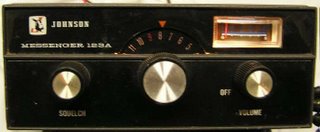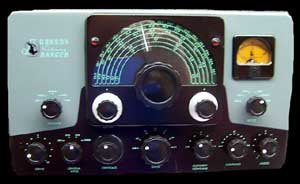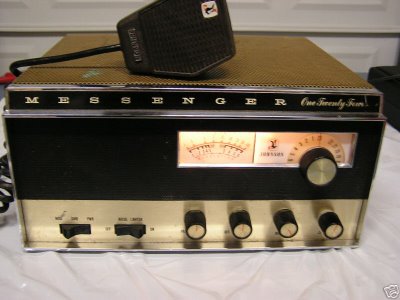
 fair to employee's, and even in those early days, unlike other corporations, he did not pigeon-hole women into secretary only positions.
fair to employee's, and even in those early days, unlike other corporations, he did not pigeon-hole women into secretary only positions. E.F. Johnson "Viking"
E.F. Johnson "Viking" uality - thanks to his nature of being a perfectionist, as well as the graphics that went along with it.
uality - thanks to his nature of being a perfectionist, as well as the graphics that went along with it. as required to make use of all that power), thus came the E.F. Johnson "Match Box", a tuner that was also available in a 1KW version.
as required to make use of all that power), thus came the E.F. Johnson "Match Box", a tuner that was also available in a 1KW version. ith any other.
ith any other.  The successor to the "Messenger" was appropriately name the E.F. Johnson "Messenger II", and while the "BOX" is basically the same, you can see a distinct change in the cosmetics - in other words, the Messenger II was a smart looking rig. The "Messenger" stood for so much, during several decades that one last Messenger sits on display at the Smithsonian!
The successor to the "Messenger" was appropriately name the E.F. Johnson "Messenger II", and while the "BOX" is basically the same, you can see a distinct change in the cosmetics - in other words, the Messenger II was a smart looking rig. The "Messenger" stood for so much, during several decades that one last Messenger sits on display at the Smithsonian! 

- Manufacturer a quality product in the U.S.
- And, compete price-wise with their Japanese counterparts! (even Lafayette Radio Electronics were having rigs made in Japan, and not just solid-state radios either).
Nonetheless, the flood from Japanese CB's took their toll on American CB Manufacturer's and in August of 1977, the E.F. Johnson company asked the International Trade Commission to increase tariffs or impose quotas to cut what it saw as an "excessive number" of CB's coming into the US from Japan and other countries. Perhaps they were too late in their request, or, maybe Edgar saw the writing on the wall - whatever the case may be, 3 months later in Novemeber of 1977, the company announced it's plans to close one of it's two Citizens Band radio manufacturing plants.

With Citizens Band on the decline, and with the rise in use of Cell phones, Johnson accepted a merger with Western Union in 1982, and in 1997 the E.F. Johnson Company was told the Nebraska based Transcrypt International, Inc.
Of other note, in E.F. Johnson v. Uniden Corp. of America, a preliminary injunction was issued against Uniden for alleged infringing E.F. Johnson's program for 2-way trunked mobile radio system by reverse engineering the EPROM.
6N2
E.F.JOHNSON
"THUNDERBOLT"
(Johnson also made a "6N2 Thunderbolt." 5 watts SSB/DSB in got you 1200W to the finals in class AB1, and six watts CW got you a happy kW of class C input on your favorite weak signal channel.)
-
Edgar passed away in 1999 of cancer, and his wife followed a scant 2 months later, but they both left a legacy of Innovation and Quality (many rigs, both HAM and CB, are still working).
-
*NOTE: As I mentioned in a previous article ("Meat and Potato Rigs Part One") my favorite SSB rig was the E.F. Johnson 352. In the late 80's, when I decided that I wanted to collect CB's, this one was first on my list, but even as hard as I looked, I never found one at either a large hamfest or a small tailgate sale.
PRE-EBAY COLLECTORS
-
In the early 90's I discovered a network of CB "Broker's", that had a list of rigs that were available, the condition they were in and a starting price. The two biggest were Bob in California and Charlie in Maine. Charlie had numerous contacts and as a rule, never actually saw the rig in question - he was the middle man, the "Broker".
-
You would talk to Charlie, and ONLY Charlie, and when it became a "Done Deal", you'd send the money to Charlie; Charlie would keep his portion and send the rest to the actual seller, and then the seller would ship directly to you. This is how I was able to obtain the Viking 352 I'd been searching for...for so long. I believe the price was about $160, but I had it at last!
-
Eventually, by word of mouth, your name would get around and other Brokers would call you out of the blue. The prices were high, and you couldn't see a picture of the rig before the sale, but it was the best thing going pre-Ebay.
TRIVIA QUESTION ANSWER:
E.F. Johnson made 5 CB Sideband rigs
- EFJ-350
- EFJ-351
- EFJ-352
- EFJ-4730
- EFJ-4740
-
-




This comment has been removed by the author.
ReplyDeleteI just wanted to say that there is a correction to your blog or whatever you wish to call it. E.F Johnson's wife passed away 2 days following his death and they had a joint funeral. I know that this does not change anything about Edgar Johnson, he was indeed a great man and this is your own take on the "CB daze", for people that look at this for information, it would be more accurate to change the date of Ethel's death to the correct date, 2-13-91.
ReplyDeleteThanks for the great info as well.